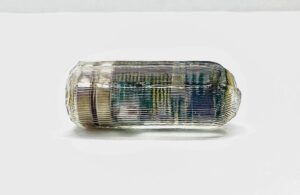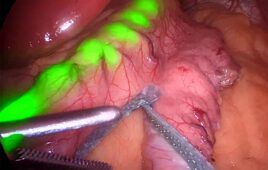
MIT engineers demonstrated that they can use magnetic fields to track the location of this ingestible sensor within the GI tract. [Image courtesy of the researchers]
This advance could help with the diagnosis of constipation, gastroesophageal reflux disease and gastroparesis.
The engineers designed their tiny sensor to detect a magnetic field produced by an electromagnetic coil located outside of the patient’s body. The strength of the field varies with distance from the coil, which allows for the calculation of the sensor’s position based on its measurement of the magnetic field.
In a new study, the researchers demonstrated the ability to track the sensor as it moved through the digestive tract of large animals. They believe this could offer an alternative to more invasive procedures — like endoscopy — used to diagnose motility disorders.
Giovanni Traverso, associate professor of mechanical engineering at MIT, is one of the senior authors of the study, published today in Nature Electronics. Traverso also works as a gastroenterologist at Brigham and Women’s Hospital.
“Many people around the world suffer from GI dysmotility or poor motility, and having the ability to monitor GI motility without having to go into a hospital is important to really understand what is happening to a patient,” said Traverso.
Azita Emami, a professor of electrical engineering and medical engineering at Caltech, and Mikhail Shapiro, a professor of chemical engineering at Caltech and an investigator of the Howard Hughes Medical Institute, were senior authors. Saransh Sharma, a Caltech grad student, and Khalil Ramadi, assistant professor of bioengineering at New York University, were lead authors.
How the sensor works
The engineers said they wanted to come up with a less invasive alternative to endoscopy that can be done at the patient’s home.
Related: Endiatx’s pill-sized robot sees and swims inside the stomach
The researchers developed a sensor small enough to fit inside an ingestible capsule to take advantage of the distance factor and its effect on the strength of the electromagnetic coil. The sensor measures the surrounding magnetic field to calculate its distance from the coil outside the body.
“Because the magnetic field gradient uniquely encodes the spatial positions, these small devices can be designed in a way that they can sense the magnetic field at their respective locations,” Sharma said. “After the device measures the field, we can back-calculate what the location of the device is.”
The system also includes a second sensor that remains outside the body — taped to the skin, for example — to act as a reference point. It allows the researchers to accurately calculate where the sensor in the GI tract is located.
The researchers said their ingestible sensor also includes a wireless transmitter. This transmitter sends the measurements to a nearby computer or smartphone. Currently, the researchers have a design that takes a measurement any time it receives a wireless trigger. However, they say they can program it to take measurements at specific intervals.
At present, the sensor can detect a magnetic field from coils within a distance of 60 centimeters or less. The researchers say they could place coils in a patient’s backpack or jacket. This allows the ingestible sensor to take measurements whenever in range.
More on the location tracking
The researchers tested their system in a large animal model. They placed the capsule in the stomach and monitored its location as it moved through the digestive tract over several days.
In the first attempt, the researchers delivered two magnetic sensors attached to each other by a small rod. That ensured they knew the exact distance between them. They compared measurements to the known distance and found they were accurate to about two millimeters.
Then, the researchers tested a single ingestible sensor with an external sensor attached to the skin. They found that they could track it as it moved from the stomach to the colon before excretion. Comparing their accuracy with X-ray measurements, the researchers determined accuracy within five to 10 millimeters.
“Using an external reference sensor helps to account for the problem that every time an animal or a human is beside the coils, there is a likelihood that they will not be in exactly the same position as they were the previous time,” Ramadi said. “In the absence of having X-rays as your ground truth, it’s difficult to map out exactly where this pill is, unless you have a consistent reference that is always in the same location.”
The researchers aim to work with collaborators to develop manufacturing processes for the system. They believe this method could make it easier for doctors to determine where slowdowns occur in the GI tract. According to MIT, they hope to eventually bring it to human clinical trials.
“The ability to characterize motility without the need for radiation, or more invasive placement of devices, I think will lower the barrier for people to be evaluated,” Traverso said.
The National Science Foundation, the Rothenberg Innovation Initiative, and the Heritage Medical Research Institute funded the research.
Related: 29 cutting-edge medtech innovations recognized with Edison Awards




